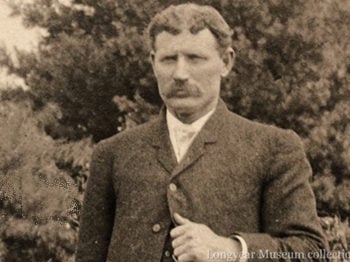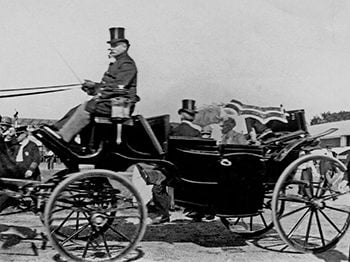The kitchen at 400 Beacon Street just wouldn’t be complete without its large stove. Nor would Adam Dickey’s bedroom be right without its bed. And no matter how magnificent his desk, Calvin Frye’s office would be missing something special without the unique curved Hammond typewriter.

These were among the furnishings that were no longer part of the house inventory when Longyear purchased Mary Baker Eddy’s final home in Chestnut Hill, Massachusetts.
While the restoration of the house was still under way, Longyear’s Historic House and Collections teams examined historic photographs to plan where they would place the original furniture and art in Mrs. Eddy’s rooms and many of the public rooms. But little remained from the kitchen and the bedrooms belonging to members of the household.
The gaps would need to be filled with hundreds of props—furnishings that are not part of the museum collection but are used to enrich the understanding of how the rooms were used. So the search began.
As was true of the restoration as a whole, this work required prayer, patience, persistence. There were countless instances of finding a good match for a vase or dresser or side table in an antique shop. Still other items, such as maps or works of art, were reproduced by Longyear staff. But the examples featured here stood out for the behind-the-scenes efforts and the sellers’ understanding that the broader public could benefit from seeing their cherished treasures on tours of Mrs. Eddy’s home.
‘Almost like a family member’

The kitchen, for instance, was actually missing two stoves, according to the old photos. But the smaller of them—a Vulcan gas range—was found in the basement in rough condition. David Erickson of Erickson’s Antique Stoves in Littleton, Massachusetts, took on the job of restoring it. One day, a Longyear consultant “came to me looking for a Magee Double Oven Kitchener, which is a very, very rare bird,” he says, “and the only one I knew of was the one I looked at every day in my own kitchen. … It was almost like a family member, and I wasn’t really interested in selling it.”
The search for the Magee, a top-of-the-line coal- and wood-burning stove in its day, had not turned anything up, until the consultant “came back to one of our meetings with pictures of the stove Dave had,” says Rex Nelles, senior manager of historic houses. It was an exact match, other than the fact that Mrs. Eddy’s had been purchased in 1907 and Dave’s was from 1908. “It’s the only one that we’ve seen,” Rex adds. “Every time we do new projects, we go to different architectural salvage yards, and I have still never seen another of those stoves from the early 1900s.”
Cast iron stoves are scarce partly because many people turned them in for metal drives during World War II. Dave had bought the heavy iron stove in New Hampshire and remembers laboring with an assistant to move it from a basement up a grassy hill in order to load it. To him, it was a keeper.
“My kids grew up in front of it. We cooked our Thanksgiving turkeys [in it], … my Springer Spaniel dog slept in front of it all the time,” he says. But he was finally persuaded that placing it in a historic house was worthwhile. “It left a big hole … but it certainly found its rightful home.”
Dave put a bright blue stove from Denmark in the massive stove’s place and replaced that a few years later when he came across a smaller version of the Magee, which he converted to run on propane. Many visitors have already appreciated seeing his former family stove in Mrs. Eddy’s kitchen. “I was honored to be a part of that project,” Dave says.
A grandmother’s bed
Chris Rankin, the site manager at 400 Beacon Street, joined the Longyear staff in 2022, bringing with him experience as a collector of teacups and Civil War memorabilia and as a buyer and seller on eBay. His first prop-hunting mission was to find a brass bed. Working online, he found an individual in Dorchester, Massachusetts, who was selling a bed identical to the one in photographs of Laura Sargent’s room. It came complete with metal plates identifying the maker and style, which then helped Chris search online for another bed for Adam Dickey’s room.
It took about a year to find a match. Finally, he came across a listing on Facebook Marketplace. The seller told him he had almost pulled down the listing because it was his grandmother’s bed and he wasn’t sure he wanted to sell it. But since Chris represented a museum, the seller decided to go ahead and negotiate. They reached a basic agreement, but the seller left on vacation before it was finalized.

Then Chris waited. For weeks. He reached out but didn’t hear back. “I think I might have lost the deal,” he mentioned to some Longyear trustees as they were departing from a meeting. They immediately responded with prayerful support, sharing some ideas before they got in the car. “As they were pulling out … I got a text from this guy,” Chris says with a smile. The seller had been stuck longer than expected during his travels, without cell service. But now he was on his way back home and ready to sell.
A typewriter’s transatlantic journey
Over the years, as both a collector and seller, Chris has learned the value of getting to know a seller before asking for discounts or special treatment. When you “really appreciate them and what they have, they’re almost always willing to work with you in some way,” he explains. “The relationship is super important.”

When he began searching for a Hammond typewriter that matched what Calvin Frye had used in his secretarial work for Mrs. Eddy, Chris turned up some expensive options on Google and eBay. Then it occurred to him to try the website Etsy, which often has vintage items for sale.
He quickly found a man in the Netherlands who collected typewriters and had the desired 1898 Hammond model 2. Chris began emailing him, explaining Longyear’s mission and sharing some historic photographs of Mr. Frye’s desk and typewriter.
“Knowing that we were going to take care of this piece, [that] it wasn’t just going to be on a shelf in somebody’s office,” prompted the seller to offer Longyear half price and free shipping, Chris notes.
“You could really tell he loved what he did. … He was more interested in finding a good home for his baby than he was concerned about the money.”
Sometimes the hunt for an item also sparks interest in Mrs. Eddy. On an antiquing trip in Connecticut, Rex and Chris visited a small shop with a lone man sitting behind a desk. They were considering a pen holder and mentioned that it would be for an historic house of Mary Baker Eddy’s. “He asked, ‘Who is Mrs. Eddy? What did she do?’” Chris recalls. “So we shared with him.”
The seller loved hearing about the Christianity at the root of Longyear’s mission, so he offered a discount on the pen stand and a free mother-of-pearl pen from the same period. It wasn’t a big-ticket item, but “he wanted to give us something,” says Chris. “Once people know what we are doing, they help us.”
Stacy A. Teicher is a senior research associate at Longyear Museum.








